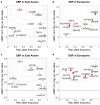Meta-analysis of genome-wide association studies identifies common variants associated with blood pressure variation in east Asians
- PMID: 21572416
- PMCID: PMC3158568
- DOI: 10.1038/ng.834
Meta-analysis of genome-wide association studies identifies common variants associated with blood pressure variation in east Asians
Abstract
We conducted a meta-analysis of genome-wide association studies of systolic (SBP) and diastolic (DBP) blood pressure in 19,608 subjects of east Asian ancestry from the AGEN-BP consortium followed up with de novo genotyping (n = 10,518) and further replication (n = 20,247) in east Asian samples. We identified genome-wide significant (P < 5 × 10(-8)) associations with SBP or DBP, which included variants at four new loci (ST7L-CAPZA1, FIGN-GRB14, ENPEP and NPR3) and a newly discovered variant near TBX3. Among the five newly discovered variants, we obtained significant replication in the independent samples for all of these loci except NPR3. We also confirmed seven loci previously identified in populations of European descent. Moreover, at 12q24.13 near ALDH2, we observed strong association signals (P = 7.9 × 10(-31) and P = 1.3 × 10(-35) for SBP and DBP, respectively) with ethnic specificity. These findings provide new insights into blood pressure regulation and potential targets for intervention.
Figures




References
-
- Ezzati M, et al. Selected major risk factors and global and regional burden of disease. Lancet. 2002;360:1347–1360. - PubMed
-
- Lopez AD, et al. Global and regional burden of disease and risk factors, 2001: systematic analysis of population health data. Lancet. 2006;367:1747–1757. - PubMed
-
- Lawes CMM, Vander Hoorn S, Rodgers A. International Society of Hypertension. Global burden of blood-pressure-related disease, 2001. Lancet. 2008;371:1513–1518. - PubMed
-
- Kearney PM, et al. Global burden of hypertension: analysis of worldwide data. Lancet. 2005;365:217–223. - PubMed
-
- He J, et al. Premature deaths attributable to blood pressure in China: a prospective cohort study. Lancet. 2009;374:1765–1772. - PubMed
Publication types
MeSH terms
Grants and funding
LinkOut - more resources
Full Text Sources
Miscellaneous

